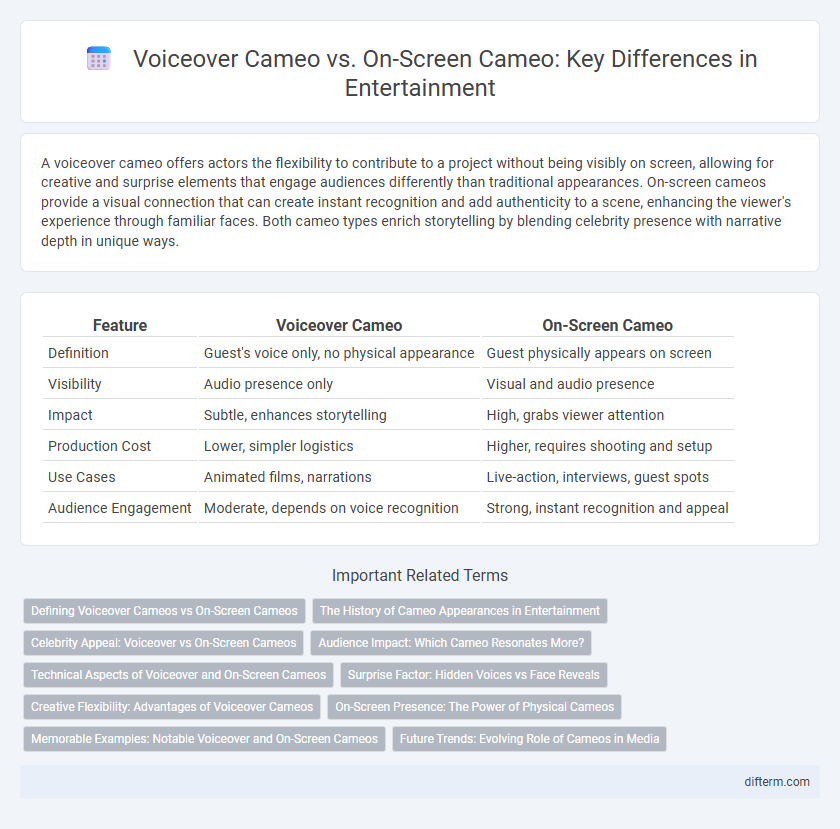A voiceover cameo offers actors the flexibility to contribute to a project without being visibly on screen, allowing for creative and surprise elements that engage audiences differently than traditional appearances. On-screen cameos provide a visual connection that can create instant recognition and add authenticity to a scene, enhancing the viewer's experience through familiar faces. Both cameo types enrich storytelling by blending celebrity presence with narrative depth in unique ways.
Table of Comparison
| Feature | Voiceover Cameo | On-Screen Cameo |
|---|---|---|
| Definition | Guest's voice only, no physical appearance | Guest physically appears on screen |
| Visibility | Audio presence only | Visual and audio presence |
| Impact | Subtle, enhances storytelling | High, grabs viewer attention |
| Production Cost | Lower, simpler logistics | Higher, requires shooting and setup |
| Use Cases | Animated films, narrations | Live-action, interviews, guest spots |
| Audience Engagement | Moderate, depends on voice recognition | Strong, instant recognition and appeal |
Defining Voiceover Cameos vs On-Screen Cameos
Voiceover cameos involve celebrities lending their voices to animated characters or narration without appearing visually on screen, enhancing the auditory experience and often adding a layer of familiarity through vocal recognition. On-screen cameos feature brief physical appearances by well-known personalities within live-action scenes, creating a visual surprise that engages audiences and often serves as an Easter egg. Both forms capitalize on star power but differ in sensory impact, with voiceover cameos emphasizing sound and on-screen cameos relying on visual presence.
The History of Cameo Appearances in Entertainment
Cameo appearances in entertainment date back to early cinema, where actors frequently made brief on-screen appearances to surprise audiences or pay homage. Voiceover cameos emerged as animation and radio gained popularity, allowing celebrities to lend their voices without physical presence, enhancing storytelling with recognizable vocal talent. Both forms of cameos enrich narratives by creating rewarding moments for fans, while showcasing the evolving nature of celebrity involvement across media formats.
Celebrity Appeal: Voiceover vs On-Screen Cameos
Celebrity appeal in voiceover cameos lies in the distinctiveness of a recognizable voice adding unique personality without altering the visual narrative, while on-screen cameos leverage the physical presence and charisma of celebrities to create memorable visual moments. Voiceover cameos often generate intrigue by tapping into audience familiarity with the star's vocal tone and style, enhancing brand connection and narrative depth. On-screen cameos deliver immediate impact through visual recognition and star power, often sparking buzz and social media engagement by showcasing celebrities in unexpected roles or brief appearances.
Audience Impact: Which Cameo Resonates More?
Voiceover cameos engage audiences through unique vocal presence, often surprising listeners with recognizable voices that enhance storytelling without visual distraction. On-screen cameos deliver immediate visual impact, leveraging the celebrity's physical appearance to create memorable moments that resonate strongly with viewers. Audience preferences often depend on the medium and context, with voiceover cameos excelling in animated or audio-focused entertainment, while on-screen cameos dominate live-action formats for maximum recognition and emotional connection.
Technical Aspects of Voiceover and On-Screen Cameos
Voiceover cameos require precise audio recording techniques such as time-synchronized lip-sync and sound mixing to seamlessly integrate with the main narrative, often utilizing advanced microphones and sound editing software. On-screen cameos demand exact on-set lighting, camera angles, and actor positioning to maintain visual continuity and ensure the cameo blends naturally within the scene. Both formats rely heavily on post-production processes; voiceovers focus on audio clarity and tonal matching, while on-screen appearances prioritize color grading and visual effects alignment.
Surprise Factor: Hidden Voices vs Face Reveals
Voiceover cameos create a unique surprise factor by concealing the actor's identity, allowing audiences to recognize familiar voices without visual confirmation, which heightens curiosity and engagement. On-screen cameos deliver immediate impact through face reveals, generating instant excitement and recognition that can enhance a scene's memorability. The contrast between hidden voices and visual appearances shapes audience anticipation and emotional response, making each cameo style distinct in driving entertainment value.
Creative Flexibility: Advantages of Voiceover Cameos
Voiceover cameos offer unparalleled creative flexibility by allowing actors to portray characters beyond physical appearance constraints, enabling the inclusion of high-profile talent in animated or CGI-heavy projects without on-set presence. This format facilitates quick scheduling and remote recording, reducing production complexities and costs compared to on-screen cameos. Moreover, voiceover cameos can seamlessly integrate into diverse storytelling styles, enhancing narrative depth without disrupting visual continuity.
On-Screen Presence: The Power of Physical Cameos
On-screen cameos leverage the actor's physical presence to create a memorable impact that voiceover cameos cannot replicate, engaging the audience visually and emotionally. The physicality, facial expressions, and body language of on-screen appearances contribute to a stronger connection with viewers, enhancing the storytelling experience. Iconic examples include Stan Lee's cameos in Marvel films, where his visible presence became a cultural hallmark.
Memorable Examples: Notable Voiceover and On-Screen Cameos
Notable voiceover cameos include Morgan Freeman's narration in "March of the Penguins" and Stan Lee's iconic lines in numerous Marvel movies, both adding distinct character to the storytelling without appearing on screen. Memorable on-screen cameos such as Alfred Hitchcock's brief appearances in his own films and Matt Damon's surprise role in "Thor: Ragnarok" create a visual layer of delight for audiences and convey playful connections to the narrative. These cameo styles serve different yet powerful roles in enhancing audience engagement and enriching the entertainment experience.
Future Trends: Evolving Role of Cameos in Media
Voiceover cameos in entertainment are increasingly embraced for their flexibility, allowing iconic voices to appear without physical presence and enhancing immersive storytelling through animation and gaming. On-screen cameos remain valuable for visual impact and surprise, but future trends suggest a hybrid approach where digital avatars enable celebrities to bridge both voice and physical likeness across virtual and augmented reality platforms. This evolution underscores the growing importance of technology in expanding cameo roles, creating interactive and personalized media experiences.
voiceover cameo vs on-screen cameo Infographic

 difterm.com
difterm.com